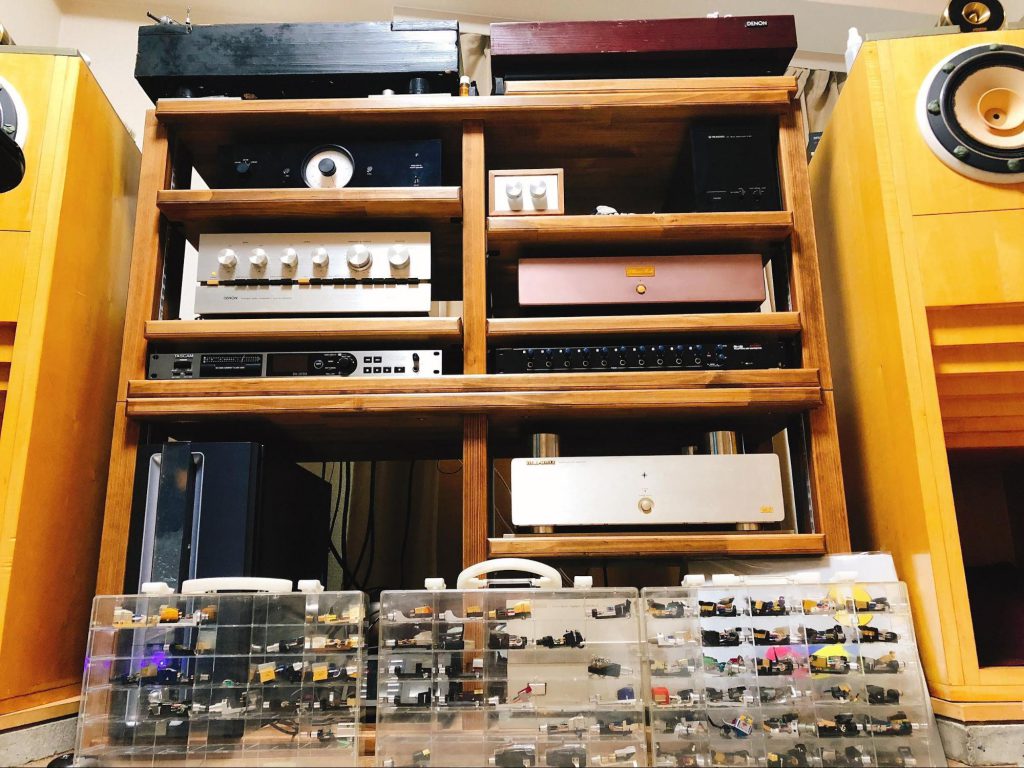

We interviewed with Mr. Shingo Karasawa, the representative of his own shell lead workshop “KS-Remasta.” He says “The sharpness of the edge tool changes the sound.”
– You have many Mariah Carey’s records.
Yes. I have almost all.
– So many cartridges are in the case.
They are my property. This case are for toy car originally.
– When did you get interested in records?
The first EP record I bought is Momoe Yamaguchi’s “Play Back part 2” and the first LP is Kai Band’s “Kai Band Story.” In my junior high school days I start to listen to Western music, and in my high school days I start to buy imported records. I liked the smell of the imported record store. I don’t know how to express it. I thought it is the smell of foreign countries.
CDs were more expensive than records at the time, so I listened to records thinking “Probably CD has better sound.” When I was about 30, I compare the sound of them with the Mariah Carey’s work, the sound of record is more charming and dynamic.


– Why did you start to make shell leads?
One day the cartridge I had planned to buy got discontinued. After that I’ve started to buy the cartridges I want before it gets discontinued. When my collection reached about 30, I came to want the shell leads which can reproduce pure sound from my cartridges. I wondered the leads attached to the cartridges by the makers can reproduce the sound close to the original?
The lead for about 10$ reproduced fine and distinctive sound but I felt “this is not pure sound.” And the lead for 40$ made in foreign country were released soon. That reproduced elegant and beautiful sound. I wanted to buy complete set for my 30 cartridges, but it was hard. So I made them by myself soldering them.
– Did you have the knowledge about electricity and the soldering technic?
No. So I couldn’t do well. At such time I saw the process of soldering the terminal of speaker in the speaker-making cercle. I imitated it and got the technic little by little. And I met the teacher who teach me about shell leads.
I got known as the craftsman and introduced in the magazine. The magazine evaluated me highly so I started up “KS-Remasta.” I used vintage wire for the highly-rated product. I peeled the enamel of vintage wire carefully and it led to good sound.


– Carefulness changes the sound?
Peeling the enamel little by little with the sharp edged tool. Carefulness doesn’t need for soldering and reproducing but simply I don’t like the finish. However probably it led to the sound quality. After that, I changed my tool from craft knife to medical knife. High-end leads are so thin as hair. The leads of this model are covered by threads and I peel them. After I changed the tool, customers said “sound gets better.” I didn’t know why the sound changed at that time. One day my teacher said to me “your works are sometimes really good and sometimes not so good.” I want to make the flagship model “Legend,” and the model should not have the individual difference. And I realized “the sharpness of edged tool changes the sound.”
I researched and found the tools made of “yasuki-hagane” have great sharpness. And I decided to use the tool made of “yasuki-shiroichi-hagane” which is said to be the closest to “tamahagane,” the material of Japanese sword. It was hard to find this, but I found it in the online auction. It didn’t sold as “edged tool”, but “antique.”
The scalpel increased the speed of the solder spreading. It slips on the surface of the conductor at high speed. I felt the same sense as “Stage series” which whose conductor is mirror finished. Originally I use the scalpel for peeling the enamel clean, but now for polishing it up. It resulted in the pure sound. I kept searching and now I use the other steel (KS-Remasta No.4). The conductor after mirror finish feels so “moist”.
– The product can reproduce the sound which can’t hear before?
Yes. It finds the subtle components which is hard to explain verbally like indirect sound and atmosphere. I’m sure that polishing the conductor is the extremely effective way to allow subtle signals to pass through. Conversely, subtle signals get lost in uneven conductor. Analog can pick up many signals and that is the biggest attraction of analog for me. Better accuracy of finishing produces better sound. Our cartridges picks up so many signals and polishing brings out them. I will keep challenging my limit from now on.

– What is analog record to you?
Privacy & Cookies Policy
Privacy Overview
This website uses cookies to improve your experience while you navigate through the website. Out of these cookies, the cookies that are categorized as necessary are stored on your browser as they are as essential for the working of basic functionalities of the website. We also use third-party cookies that help us analyze and understand how you use this website. These cookies will be stored in your browser only with your consent. You also have the option to opt-out of these cookies. But opting out of some of these cookies may have an effect on your browsing experience.
Necessary cookies are absolutely essential for the website to function properly. This category only includes cookies that ensures basic functionalities and security features of the website. These cookies do not store any personal information.
